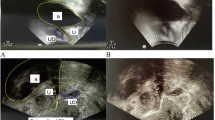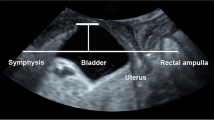Abstract
In patients with genital prolapse involving several compartments simultaneously, radiologic investigation can be used to complement the clinical assessment. Contrast medium in the urinary bladder enables visualization of the bladder base at cystodefecoperitoneography (CDP). The aim of the present study was to evaluate the correlation between clinical examination using the Pelvic Organ Prolapse Quantification system (POP-Q) and CDP. Thirty-three women underwent clinical assessment and CDP. Statistical analysis using Pearson’s correlation coefficient (r) demonstrated a wide variability between the current definition of cystocele at CDP and POP-Q (r=0.67). An attempt to provide an alternative definition of cystocele at CDP had a similar outcome (r=0.63). The present study demonstrates a moderate correlation between clinical and radiologic findings in patients with anterior vaginal wall prolapse. It does not support the use of bladder contrast at radiologic investigation in the routine preoperative assessment of patients with genital prolapse.




Similar content being viewed by others
Abbreviations
- CDP:
-
Cystodefecoperitoneography
References
Olsen AL, Smith VJ, Bergstrom JO, Colling JC, Clark AL (1997) Epidemiology of surgically managed pelvic organ prolapse and urinary incontinence. Obstet Gynecol 89:501–506
Mellgren A, Bremmer S, Johansson C et al. (1994) Defecography. Results of investigations in 2,816 patients. Dis Colon Rectum 37:1133–1141
Maglinte DD, Kelvin FM, Fitzgerald K, Hale DS, Benson JT (1999) Association of compartment defects in pelvic floor dysfunction. Am J Roentgenol 172:439–444
Kelvin FM, Maglinte DD, Hornback JA, Benson JT (1992) Pelvic prolapse: assessment with evacuation proctography. Radiology 184:547–551
Kelvin FM, Maglinte DD, Benson JT, Brubaker LP, Smith C (1994) Dynamic cystoproctography: a technique for assessing disorders of the pelvic floor in women. Am J Roentgenol 163:368–370
Altringer WE, Saclarides TJ, Dominguez JM, Brubaker LT, Smith CS (1995) Four-contrast defecography: pelvic “floor-oscopy”. Dis Colon Rectum 38:695–699
Kenton K, Shott S, Brubaker L (1997) Vaginal topography does not correlate well with visceral position in women with pelvic organ prolapse. Int Urogynecol J 8:336–339
Delemarre JB, Kruyt RH, Doornbos J et al. (1994) Anterior rectocele: assessment with radiographic defecography, dynamic magnetic resonance imaging, and physical examination. Dis Colon Rectum 37:249–259
Bremmer S, Ahlback SO, Uden R, Mellgren A (1995) Simultaneous defecography and peritoneography in defecation disorders. Dis Colon Rectum 38:969–973
Lienemann A, Anthuber C, Baron A, Kohz P, Reiser M (1997) Dynamic MR colpocystorectography assessing pelvic-floor descent. Eur Radiol 7:1309–1317
López A, Anzen B, Bremmer S et al. (2002) Cystodefecoperitoneography in patients with genital prolapse. Int Urogynecol J 13:22–29
Bump RC, Mattiasson A, Bo K et al. (1996) The standardization of terminology of female pelvic organ prolapse and pelvic floor dysfunction. Am J Obstet Gynecol 175:10–17
Hall AF, Theofrastous JP, Cundiff GW et al. (1996) Interobserver and intraobserver reliability of the proposed International Continence Society, Society of Gynecologic Surgeons, and American Urogynecologic Society pelvic organ prolapse classification system. Am J Obstet Gynecol 175:1467–1470
Bland DR, Earle BB, Vitolins MZ, Burke G (1999) Use of the Pelvic Organ Prolapse staging system of the International Continence Society, American Urogynecologic Society, and Society of Gynecologic Surgeons in perimenopausal women. Am J Obstet Gynecol 181:1324–1327
Kelvin FM, Maglinte DD, Hale DS, Benson JT (2000) Female pelvic organ prolapse: a comparison of triphasic dynamic MR imaging and triphasic fluoroscopic cystocolpoproctography. Am J Roentgenol 174:81–88
Yoshioka K, Matsui Y, Yamada O et al. (1991) Physiologic and anatomic assessment of patients with rectocele. Dis Colon Rectum 34:704–708
Bremmer S, Mellgren A, Holmstrom B, Lopez A, Uden R (1997) Peritoneocele: visualization with defecography and peritoneography performed simultaneously. Radiology 202:373–377
Colton T (1974) Statistics in medicine. Little Brown & Co, Boston
Sentovich SM, Rivela LJ, Thorson AG, Christensen MA, Blatchford GJ (1995) Simultaneous dynamic proctography and peritoneography for pelvic floor disorders. Dis Colon Rectum 38:912–915
Halligan S, Bartram CI (1995) Evacuation proctography combined with positive contrast peritoneography to demonstrate pelvic floor hernias. Abdom Imag 20:442–445
Rinne KM, Kirkinen PP (1999) What predisposes young women to genital prolapse? Eur J Obstet Gynecol Reprod Biol 84:23–25
Barber MD, Lambers A, Visco AG, Bump RC (2000) Effect of patient position on clinical evaluation of pelvic organ prolapse. Obstet Gynecol 96:18–22
Kelvin FM, Hale DS, Maglinte DD, Patten BJ, Benson JT (1999) Female pelvic organ prolapse: diagnostic contribution of dynamic cystoproctography and comparison with physical examination. Am J Roentgenol 173:31–37
Anderson J, Carrion R, Ordorica R, Hoffman M, Arango H, Lockhart JL (1998) Anterior enterocele following cystectomy for intractable interstitial cystitis. J Urol 159:1868–1870
Acknowledgments
Presented at the 10th European Symposium on Urogenital Radiology, Uppsala, Sweden, 4–7 September, 2003.
Author information
Authors and Affiliations
Corresponding author
Additional information
Editorial Comment: The authors attempt to correlate the visceral position of the bladder on fluoroscopy to the anterior vaginal wall measurements on POP-Q examination. Consistent with other published reports, they show only moderate statistical correlations. Clinically, the correlations are probably not useful. Thirty-eight percent of women with radiographic cystoceles had no clinically significant prolapse (stage III or IV). Based on their findings the authors conclude that the routine use of radiologic investigation might not be warranted in the preoperative assessment of women with pelvic organ prolapse. This must be interpreted with caution when generalizing their data to all women with prolapse. Only 17% of the women in this study had had prior pelvic surgery. The authors also do not address how cystodefecoperitoneography results affected the diagnosis of enterocele or rectocele. Other authors have shown a significant increase in enterocele diagnosis using cystodefecoperitoneography.
Rights and permissions
About this article
Cite this article
Altman, D., Mellgren, A., Kierkegaard, J. et al. Diagnosis of cystocele – the correlation between clinical and radiological evaluation. Int Urogynecol J 15, 3–9 (2004). https://doi.org/10.1007/s00192-003-1111-y
Received:
Accepted:
Published:
Issue Date:
DOI: https://doi.org/10.1007/s00192-003-1111-y




